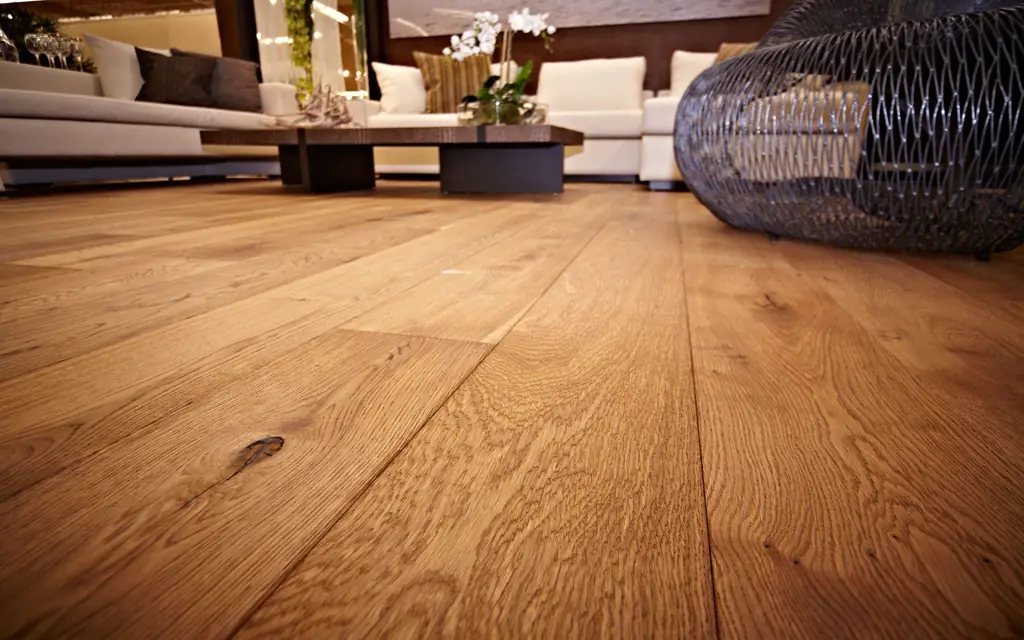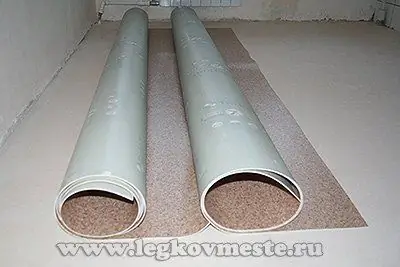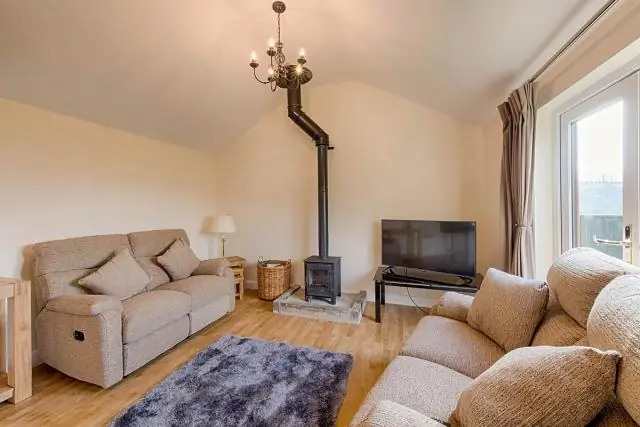
Table of contents:
- Author Bailey Albertson [email protected].
- Public 2023-12-17 12:53.
- Last modified 2025-06-01 07:32.
How to eliminate parquet creaking yourself: expert advice

Today, the building materials market offers customers many types of flooring in various price categories. But many continue to give preference to the good old parquet, which has proven itself from the best side. But even he has flaws over time. For example, he begins to creak, albeit quietly, but intrusive and unpleasant.
Content
- 1 Reasons for squeaking parquet
-
2 Remedies
- 2.1 Dismantling parquet
- 2.2 Removing potholes and cracks
- 2.3 Repair of the base of the parquet flooring
- 2.4 Wedge tamping method
- 2.5 Filling with adhesive
- 2.6 Cement mortar
- 2.7 Syringe into parquet floor
- 2.8 Pouring polyurethane foam
- 2.9 Using metal anchors
- 2.10 Broaching with self-tapping screws
- 2.11 Pulling the parquet floor
- 3 Prevention
- 4 Video on how to eliminate the squeak of parquet
The reasons for the creak of the parquet
Despite the fact that parquet belongs to the elite class of flooring, its performance can also decrease. Squeaking is the most common problem. Before you know how to get rid of it, you need to find out the cause of the unpleasant sound.
This floor covering is made from natural wood. We can say that the creak is a payment for the environmental friendliness of the material, which does not contain chemical additives that prevent shrinkage. It appears due to the detachment of the parquet planks from the base (screed with plywood sheets or concrete, bituminous mastic), in which friction is formed. A minimal movement of the planks is enough to create a creak.

The reasons for the squeak of parquet can be different
In some places of the floor, due to uneven evaporation of moisture from the parquet board, cavities are formed between the parquet and the base. Dust and debris accumulate in them. In such areas, the coating begins to "play".
In addition, the causes of the unpleasant sound include:
- drying out of parquet;
- split slats;
- scrap of a ridge or groove;
- loosening nails and screws;
- the exit of nails and screws from their nests;
- movement of the ends and lag of the boards relative to each other;
- no gap near the walls.
That is, the source can be the friction of the planks against the nails with which they are nailed, or the interaction of the parquet boards between themselves and the flooring under the covering.
Remedies
We will look at several ways to eliminate the squeak of parquet. But before that, you need to find vulnerable areas. Walk on the floor and remember the places where it is faulty. Mark these points so that remedial action can be applied to them later.
Dismantling parquet
The cardinal method of dealing with squeaking sounds is to completely replace the parquet flooring. You need to dismantle the planks, prepare the base, lay the disassembled parquet, loop it, sand it and varnish it.
You can use this method if all the dies (or most) have moved away from the base. It should be noted that this procedure is costly in terms of time and money. Therefore, if the squeak is of a local nature, it can be eliminated without removing the parquet.

If the parquet strips have moved away from the base, you need to dismantle the coating
Elimination of potholes and cracks
If, when walking, the parquet not only creaks, but also crackles quite loudly, this indicates a high temperature or low level of humidity in the room. During installation, the wood was damp, and over time it dried out. In this case, use a putty: carefully seal the cracks in the color of the parquet and cover the potholes with a thick layer. Apply imitation wood on top.
You can use casein glue mixed with sawdust. After that, sand the parquet well and cover it with wood varnish.
If the gaps are rather wide, it is better not to waste time on filling them - they will spread out anyway. In this case, the parquet plank should be replaced by choosing planks of the same size and color as the whole parquet.

Removing cracked parquet planks
Then follow the instructions.
- Split the cracked bar into several pieces with a chisel or chisel. Take them out. Starting in the middle, remove all adhesive backing.
- Thoroughly clean the cavity remaining after removing the strip. Line up the base carefully.
- Prepare a new board. From it you need to cut off the ridge, and carefully polish the cut point with a plane. If necessary, cut off ridges and grooves from adjacent parquet floors.
- If it is necessary to replace several boards located next to each other, first fasten them together to form a single rivet. Before doing this, make sure that the new planks fit exactly in place of the old ones.
- On the base, freed from parquet, pour bituminous mastic, brought to a temperature of 150-170 degrees, or another adhesive composition suitable for such work. Place the rivet on top. Carefully wipe off any excess glue or mastic. Press down on the new board with some weight.
- After the adhesive base is completely dry, sand the restored area, remove dust and varnish.
Parquet base repair
If your parquet floor is flat but still squeaks, you should place 12mm plywood sheets in glue over the base. Do this in the direction of the main installation of the planks at the desired angle. Of course, this method will not save you from the squeak forever, but it will allow you to forget about it for a long time.

Parquet flooring scheme
There is one more method of getting rid of unpleasant sounds from parquet. When using it, you need to take into account the type of base. If you laid parquet on bitumen mastic, do the following: use a construction hair dryer to heat the parquet strips so that the bitumen melts under them. Then press firmly on the dies and leave to dry.
Wedge tamping method
A common cause of squeak is poor fastening of planks to bugs or beams. To prevent this, wedges are driven between the beam and the board. If the lower part of the floor is inaccessible, the boards are fixed on the logs from above.

An example of fixing parquet boards by tamping wedges
If the parquet squeaks due to the friction of the boards with each other, drive wedges into the slots, adhering to a step of 15-20 cm. Make sure that these wedges do not protrude above the floor level.
You can use a simpler method. Just pour graphite powder or talcum powder into the cracks between the boards
Filling with adhesive
To get rid of the squeak in this way, you need:
- electric drill with a drill 2 mm;
- medical syringe;
- masking tape;
- polyurethane glue;
- wax crayons;
- rags;
- dowels.
Armed with the necessary materials and tools, get to work.
In the center of the damaged areas on the parquet, mark points equidistant from each other by 15 cm. Apply masking tape to them.
In the marked places, make 2 mm through holes in the planks. Pour the glue between the base of the floor and the parquet with a syringe.

Filling the adhesive with a syringe
Leave the work on for about an hour to allow the glue to dry. Then remove the tape. Remove traces of glue remaining on the parquet with a solvent for polyurethane foam.
Press the parquet to the base of the floor with a heavy load. Do not walk around the area being repaired for a while.
Pre-select the wax crayons to match the color of the parquet. One day after the repair, fill the holes with wax. Buff the parquet floor with a rag.
Cement mortar
With a perforator, make a hole in the floor with a diameter of no more than 2 cm. Pour cement mortar or heated bitumen inside so that the bar that creates a creak rests on it. Drive in the cork and paint over to avoid visible marks.
The same method will be even more effective if you drill a hole against the log. Pour the cement mortar inside. After a day, glue a wooden pin into the hole. With his edge, he must reach the floor slab. Remove the rest of the pin, level it with the parquet, clean, putty and paint.
You can also drill smaller holes and use liquid nails instead of screws and dowels. Glue the planks to the base, process the holes with wood-like putty
Parquet floor syringe
To implement this method, a wax-based lubricant with the addition of a special solvent is used. The prepared agent is introduced through the micro-holes under the parquet by syringing.
Alternatively, you can use an aqueous lubricant. It is fed under pressure into the cavity under the parquet floor.
Pouring polyurethane foam
Usually the space under the floor has a height of about 9 cm. To eliminate the squeak, it can be filled with polyurethane foam, which expands and stiffens the floor covering. This method has a disadvantage: during operation, the foam can over time and collapse, which is why the squeak will appear again. Therefore, this method is considered quite costly and ineffective.

The cavities formed between the parquet and the base can be filled with polyurethane foam
Using metal anchors
If the base of the parquet floor is a concrete slab, an anchor can be used. They are attached exclusively by hand. Drill a small hole, install the metal sheath and screw in the part pin.

Method of using metal anchors
This method is quite effective, but it can be costly if you need about 200 anchors, the price of which is 10-15 rubles per piece.
Broach with self-tapping screws
If a squeak occurs at the point where the parquet board touches the log, then pulling with self-tapping screws is a great way to get rid of the trouble. The biggest problem with this method is finding the lag.

Replace nails with self-tapping screws
Make sure there are no lines of communication underneath the defective floorboard. Drill a hole through the board into the log on one side with a drill. Drive a nail into it, or better, screw in a screw of the appropriate size. Be sure to drown the hat in the board.
Pulling parquet floor
The tightening process is quite time consuming, but cheap. You need to check the condition of the logs and parquet boards by brute force. It is necessary to correct the detected defects or replace damaged strips.
The method is effective in that you replace all nails with self-tapping screws that provide contraction. Self-tapping screws do not have the inherent disadvantage of nails - they do not creak at places of contact with wood
Having fixed the parquet with self-tapping screws, sand the putty area, cover it with a varnish or wax that matches the color.
Prevention
What should be done to ensure that your parquet will serve you for a long time and will not disturb you with unpleasant sounds? Our tips will help you avoid problems in advance.
-
Choose parquet from a reliable material. The best types of wood, distinguished by their strength and reliability: maple, oak, ash, teak, beech and cherry. Among exotic trees, the most commonly used parquet trees are Brazil nut, olive, sycamore, zebrano and wenge. In addition, choose a special adhesive for high quality parquet installation.

parquet board High-quality wood parquet will save you many troubles in the future
- It is better to entrust the laying work to specialists. This will require additional costs from you, but in the future you will not have to worry about dismantling and re-laying the parquet. The result of all work depends on how well the preparation of the base is carried out and the parquet board is mounted.
- Maintain your parquet properly. In the apartment, it is desirable to maintain the temperature within +20 degrees and humidity from 40 to 60%. With a regular change in these parameters, the parquet can lose its properties and begin to creak. Use special parquet care products, renew or change the varnish every 5-7 years. This will significantly extend the life of the floor.
Video on how to eliminate the squeak of parquet
We hope you do not have to waste time and money on calling specialists, because now you know several simple ways to eliminate squeak with your own hands. If you have any questions about this topic, please ask them in the comments. Or share with us your experience in rebuilding parquet flooring. We wish you easy work and comfort in your home!
Recommended:
How To Properly Lay Linoleum On A Wooden, Concrete Floor, On Plywood With Your Own Hands In An Apartment, In A Room + Installation Video

Laying linoleum on the floor in an apartment with your own hands. How to properly lay material on different types of floors, without moving furniture, and cut it to the walls
Long-term Burning Stove (including Sawdust And Wood) With Your Own Hands: Diagram, Drawings, Etc. + Video

How does a long burning stove work. Production of a long-burning furnace from a gas cylinder and sheet metal. Features of operation and repair of furnaces
How To Paint Furniture With Your Own Hands (including Old Ones) (with Video)

Detailed advice on preparing and painting furniture. Selection of materials and tools. What are the painting options
How To Make A Dehumidifier For An Apartment With Your Own Hands + Video

Types of air dryers, their principle of operation. DIY step-by-step instructions for making a desiccant
How To Clean Horizontal Blinds Correctly (including Without Removing And Quickly) + Video

Methods of washing horizontal blinds made of different materials in the removed and not removed position. Means used
